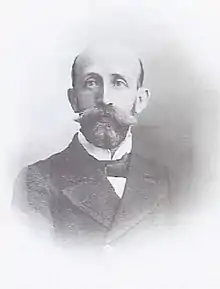Dmitry Mirimanoff
Dmitry Semionovitch Mirimanoff (Russian: Дми́трий Семёнович Мирима́нов; 13 September 1861, Pereslavl-Zalessky, Russia – 5 January 1945, Geneva, Switzerland) became a doctor of mathematical sciences in 1900, in Geneva, and taught at the universities of Geneva and Lausanne. Mirimanoff made notable contributions to axiomatic set theory and to number theory (relating specifically to Fermat's Last Theorem, on which he corresponded with Albert Einstein before the First World War[1]). In 1917, he introduced, though not as explicitly as John von Neumann later, the cumulative hierarchy of sets and the notion of von Neumann ordinals; although he introduced a notion of regular (and well-founded set) he did not consider regularity as an axiom, but also explored what is now called non-well-founded set theory and had an emergent idea of what is now called bisimulation.[2][3]

Mirimanoff became a member of the Moscow Mathematical Society in 1897.[4]
Life
Dmitry Semionovitch Mirimanoff (Russian: Дми́трий Семёнович Мирима́нов) was born in Pereslavl-Zalessky, Russia, on 13 September 1861. His parents were Semion Mirimanovitch Mirimanoff (Russian: Семён Мирима́нович Мирима́нов) and Maria Dmitrievna Rudakova (Russian: Мари́я Дми́триевна Рудакова).
Around 1885, Dmitry Mirimanoff met a French lady Malvina Geneviève Valentine Adriansen in Nice. Geneviève Adriansen learnt Russian and accepted Russian Orthodox Christianity. They married in Geneva on 25 October 1897 and had two sons: Alexander (later Alexandre) Dmitrievitch Mirimanoff (Russian: Алекса́ндр Дми́триевич Мирима́нов), born in Oranienbaum (now Lomonossov) in 1898, and Andreï (later André) Dmitrievitch Mirimanoff (Russian: Андрей Дми́триевич Мирима́нов), born in Geneva in 1902.
The family lived in Russia (first, in Moscow, then in St Petersburg) until 1900 when they moved to Geneva (in search of a better climate for Dmitry Mirimanoff's bad health). After the 1917 revolutions they never visited Russia, although Dmitry's sisters Sophia and Lydia remained there. Dmitry Mirimanoff became a Swiss citizen on 17 September 1926. Dmitry Mirimanoff died on 5 January 1945 in Geneva.
Work
Set theory
Mirimanoff in a 1917 paper introduced the concept of well-founded set and the notion of rank of a set.[5] Mirimanoff called a set x "regular" (French: "ordinaire") if every descending chain x ∋ x1 ∋ x2 ∋ ... is finite. Mirimanoff however did not consider his notion of regularity (well-foundedness) as an axiom to be observed by all sets;[3] in later papers Mirimanoff also explored what are now called non-well-founded sets ("extraordinaire" in Mirimanoff's terminology).[2]
Reflection method
In 2008, Marc Renault published an article[6] in which he pointed out that it is Dmitry Mirimanoff who should be credited for creating "the reflection method" for solving Bertrand's ballot problem, not Désiré André to whom it had been long credited. Therefore, Donald Knuth, who has read Renault's article, will credit Mirimanoff instead of André in future printings of Volume 1 of his monograph The Art of Computer Programming.[7]
References
- Jean A. Mirimanoff. Private correspondence with Anton Lokhmotov. (2009)
- Davide Sangiorgi (2011). "Origins of bisimulation and coinduction". In Davide Sangiorgi and Jan Rutten (ed.). Advanced Topics in Bisimulation and Coinduction. Cambridge University Press. pp. 18–19. ISBN 978-1-107-00497-9.
- Lorenz J. Halbeisen (2011). Combinatorial Set Theory: With a Gentle Introduction to Forcing. Springer. pp. 62–63. ISBN 978-1-4471-2172-5.
- "Состав Математического Общества". Математический Сборник. 31 (1): 1–3. 1922.
- cf. Azriel Levy (2002). Basic Set Theory. Dover Publications. p. 68. ISBN 978-0-486-42079-0. and Michael Hallett (1996). Cantorian Set Theory and Limitation of Size. Oxford University Press. pp. 186, 188. ISBN 978-0-19-853283-5.
- Renault, Marc (April 2008). "Lost (and Found) in Translation: André's Actual Method and Its Application to the Generalized Ballot Problem" (PDF). American Mathematical Monthly. 115 (4): 358–362. doi:10.1080/00029890.2008.11920537. JSTOR 27642480. S2CID 8126326.
- Donald E. Knuth. Private correspondence with Anton Lokhmotov. (2009)
External links
- Brief biography
- Brief biography
- Vandiver, H.S. (1942–1950). "Les travaux mathématiques de Dmitry Mirimanoff". L'Enseignement Mathématique. 39: 169–179. Includes a list of 60 Mirimanoff's papers.
- Mirimanoff, D. (1923). "A propos de l'interprétation géométrique du problème du scrutin" (PDF). L'Enseignement Mathématique. 23: 187–189. Describes the reflection method for solving Bertrand's ballot problem.
- Tzermias, Pavlos (2007). "On Cauchy–Liouville–Mirimanoff Polynomials". Canadian Mathematical Bulletin. 50 (2): 313–320. doi:10.4153/cmb-2007-030-7.